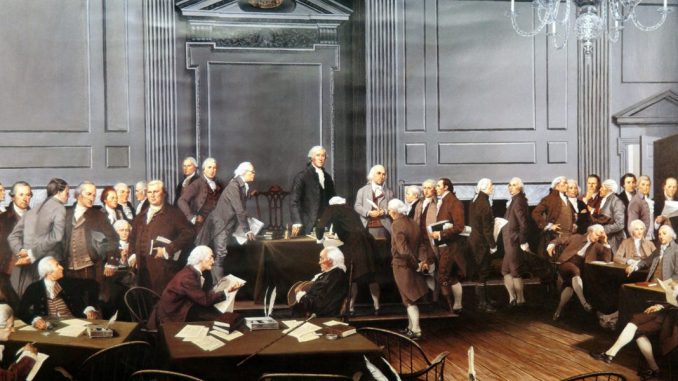
America’s First Congress
The First Congress and Congress, as we now know it, officially began on March 4, 1789.
It came into being due to America’s new Constitution, which was written in 1787. The new Constitution of the United States of America was written in 1787. It was ratified in 1788, when the 9th state (New Hampshire) ratified it on June 21, 1788. It officially began operation in 1789 and is the world’s longest surviving written charter of government.
Charting a Course
The First Congress’ necessary tasks were many and the new form of government meant the Congress was charting a new course of freedom. There were no examples for this Congress to follow, because America was the first government of a free nation controlled by “The People”. Established as a republic to protect individual rights, this new government relied upon elected officials to represent citizens. The First U.S. Congress began America’s experiment in freedom, as the world watched.
“Scarcely a day passes without some striking evidence of the delays
and perplexities springing merely from the want of precedents. ”
Representative James Madison to Edmund Randolph, May 31, 1789
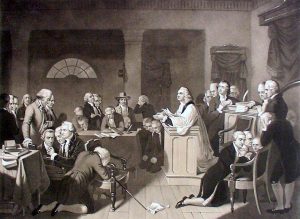
Many Firsts and Decisions
So many things America now takes for granted were up in the air. That first Congress spawned numerous precedents, from the first outside lobbying campaign, to the first treaty with a foreign nation, to the title bestowed upon the nation’s chief executive. (Note: John Adams wanted “His Majesty” instead of “President.” Appropriately, “president” was chosen.)
Those assembled were far from being like-minded, but through discussions and compromises became the most productive Congress in history. It laid out the ideas of what the government of a free nation should be. They figured out how a Congress was supposed to function.
March 4, 1789
The first day the United Sates Constitution began operation. It was the first convening of the First Federal Congress in New York City. History considers this Congress the most important Congress in American history. At this first meeting, they did not achieve the quorum required to conduct business. Bad weather and poor travel conditions, along with some amount of doubt, prevented enough of the members to assemble. But, this date is still marked as the first official session of the very First Congress of the United States of America.
And, So It Begins…
This First Congress established all legislation necessary to implement the new American government, and so solved the difficult questions left by the Constitutional Convention. They set up rules, procedures and roles of officers, such as the President of the Senate and Speaker of the House.
Their actions broke new ground. They sent the oaths of office for Congress and also for state legislators, federal executive officers, and both state and federal judges.
Additional legislation raised revenues by setting duties on imported good and they also established the Departments of State, War and Treasury, along with a temporary post office department. They created a federal judiciary, set compensation for government officials, provided for lighthouses, authorized expenses for Indian tribe negotiations and reenacted the Northwest Ordinance of 1787.
Their attempts to locate a capital or seat of federal government, however, failed in 1789, but would be resolved in 1790.
April 1, 1789
The first quorum was achieved in the United States House of Representatives. (A quorum is the minimum number of members required to conduct business.)
April 6, 1789
The first quorum was achieved in the United States Senate. The House and Senate met jointly in the Senate chamber to count the ballots of the presidential electors. George Washington received 60 votes, John Adam 34, and 35 votes were scattered among 10 other candidates.
April 30, 1789
George Washington was inaugurated in New York City as the first President of the United States under the constitution. Robert R. Livingston, Chancellor of the State of New York, on the balcony of Federal Hall, at the corner of Broad and Wall Street administered the oath.
“The eyes of America — perhaps the world — are turned to this Government…”
–George Washington to David Stuart, July 26, 1789
June 1, 1789
Congress passed its first law, “An act to regulate the time and manor of administering certain oaths.”
The Oath Act of May 5, 1789 was for Congressional members and all civil servants, was very simple: “I do solemnly swear that I will support the Constitution of the United States.” The Constitution contains the oath for the President of the United States, which is a similar oath of office. In June, the time and manner of these oaths was set.
July 27, 1789
Congress established the Department of Foreign Affairs (later changed to the Department of State).
It was James Madison, who proposed the creation of a Department of Foreign Affairs. He suggested it fall under the leadership of a Secretary of State for Foreign Affairs. But, because there wasn’t thought to be enough work for a Department of “Home Affairs,” Congress also assigned domestic duties to the new Department of State.
July 31, 1789
On July 31, 1789, the Congress passed the third of three acts that provided for administering customs tariffs and collecting duties. Earlier on the nation’s birthday, the Tariff Act of July 4, 1789, had been passed by Congress. Next followed the Duties on Tonnage statute on July 20. Then, on the last day of the month, Congress established customs districts. Administration of customs laws was placed under the secretary of the Treasury by an act of September 2, 1789.
August 7, 1789
Congress established the War Department (later changed to Department of Defense).
President Washington appointed Maj. General Henry Knox as the first secretary of this department, a position he held until the end of 1794.
The United States Department of War, also called the War Office, was the department responsible for the operation and maintenance of land (and later air) forces from 1789 until September 18, 1947, when it became part of the National Military Establishment and was renamed Department of Defense. The War Department also had responsibility for the young nation’s naval affairs until the establishment of the Navy Department in 1798.
September 2, 1789
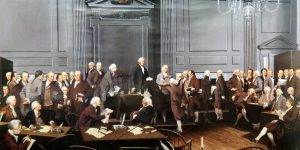
Congress began the Treasury Department.
Of note, the U.S. national debt on March 4, 1789 was $75 million, due to the cost of the war. That debt would be roughly $900 billion in today’s dollars and was 30 percent of gross domestic product in 1789. Many of the founders who helped finance the American Revolution never received or requested reimbursement for their loans.
President Washington appointed Alexander Hamilton as the first United States Secretary of the Treasury. Hamilton held this office until the last day of January 1795.
September 22, 1789
Congress created the Office of the Postmaster General under the new Constitution. Prior to this, under the Continental Congress, there had been three postmaster generals, including Benjamin Franklin, the first one.
September 24, 1789
Congress passed the Federal Judiciary Act, which set up the Supreme Court, 13 District Courts, and three Circuit Courts. Congress also created the Office of the Attorney General.
From April 1790 through September 1798, President Washington appointed 38 federal judges and 28 district judges. He appointed Justices of the Supreme Court of the United States, including the Chief Justice, a total of six members.
September 25, 1789
James Madison’s Bill of Rights was passed, as promised to the states would happen with the ratification of the Constitution. Originally, 12 amendments had been proposed. Of the 12, ten amendments were passed.
In the 18th century, serving in Congress was an honor, but it was also a great hardship. Travel between the members’ home states and to New York City or to Philadelphia, where Congress met from 1785 through 1800, was a long, rough trip.
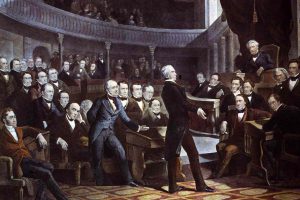
Representatives and senators found living in these cities exciting, but also expensive. Congressional pay at the time was only $6.00/day (equal to about $200.00 in 2023). During their time as our nation’s legislators, they lived away from their homes several months of each year. This left them away from livelihoods, usually both farms and businesses, along with their families. For many of them, their wives carried on the extensive tasks of their busy businesses and farms. During the 1790’s, there were resignations by about one-third of the Senate, while in office.
July 9 and 16, 1790
The seat of the federal city was established, when President George Washington signed the Permanent Seat of Government Act.
On July 9, 1790, Congress passed the Residence Act, which approved the creation of a national capital on the Potomac River. Under the Residence Act, the exact location was to be selected by President George Washington, who signed the bill into law on July 16, 1790.
The Act allowed 10 square miles of land for the federal government. The land was ceded by both Maryland and Virginia to establish the new city. The land included the two existing port cities of Georgetown and Alexandria. The Residence Act created a commission, which would be appointed and supervised by the president (George Washington), to survey and acquire land to establish a new city within the district “for the use of the United States.”
The First Congress (1789–1791) Overview
The House and Senate included a total of 65 members and finished what the Founders started. Their members included 37 Pro-Administration and 28 Anti-Administration. Despite their differences in opinions, they filled out the U.S. Constitution’s remaining framework. In the process, this First Congress addressed concerns raised during the Constitution’s ratification and created the federal architecture. They formed a revenue system, the first executive departments, and the judiciary. The First Congress also assumed state Revolutionary War debts and decided the location of the future capital. Under the leadership of Representative James Madison of Virginia, this Congress wrote and passed the constitutional amendments, which became the Bill of Rights. Congress also moved their meeting location from New York City to Philadelphia in 1790.
The Making of History
The importance of the First Federal Congress cannot be over-stated. It played an important role as the body, which began to implement and interpret the new Constitution of the United States. While the start of the government occurred at the Federal Convention, it was not until this First Congress made decisions and passed legislation that life was breathed into that government. The responsibility for the success or failure of the American Revolution rested with these members. Despite the difficult issues facing them, the members overcame their political and area differences. They left to the future a sturdy foundation on which a great nation could be built.
“All legislative Powers herein granted shall be vested in a Congress of the United States,
which shall consist of a Senate and House of Representatives.”
–U. S. Constitution: Article I, Section 1
Also, see these TFP articles:
Ratification, U.S. Constitution’s Fight for Survival – the story of how the U.S. Constitution was established.
America’s Historic Timeline – the recount of the early years of a free nation in a timeline.
The Constitution of the United States of America, an exact transcription.
The Originally Proposed Bill of Rights
https://thefoundingproject.com/ratification-u-s-constitutions-fight-survival/
https://thefoundingproject.com/originally-proposed-bill-rights/
Featured Image:
Congress Passes James Madison’s Bill of Rights – On This Day in History, Government Archives photo
The Members of the First Congress, a list:
https://www2.gwu.edu/~ffcp/exhibit/p1/members/
Sources:
Congress Center; American Archives; U.S. Senate Archives,
Findling, John E, and Frank W. Thackeray. Events That Changed America in the Eighteenth Century. Westport, Conn: Greenwood Press, 1998.
Rakove, Jack N. Original Meanings: Politics and Ideas in the Making of the Constitution. New York: Knopf, 1997,
Wood, Gordon S. Empire of Liberty: A History of the Early Republic, 1789–1815. Oxford: Oxford University Press, 2011,
National Archives – U.S. Senate, U.S. House of Representatives, Congress and History of House and Senate,
Architect of the Capital, George Washington University, U.S. Customs and Border Protection,
Links: https://congresscenters.org/events-2/congress-week/resources/; https://www.archives.gov/exhibits/treasures_of_congress/text/page2_text.html#:~:text=The%20Congress%20of%20the%20United,important%20Congress%20in%20U.S.%20history; https://teachingamericanhistory.org/resource/convention/timeline/; https://www.archives.gov/milestone-documents/articles-of-confederation#:~:text=The%20Articles%20of%20Confederation%20were,day%20Constitution%20went%20into%20effect; https://www.senate.gov/about/origins-foundations/senate-and-constitution/constitution.htm; https://www.aoc.gov/explore-capitol-campus/art/first-federal-congress-1789#:~:text=Meeting%20in%20New%20York%20at,powers%20of%20advice%20and%20consent; https://www.senate.gov/about/historic-buildings-spaces/meeting-places/washington-dc.htm#:~:text=In%201790%20Congress%20passed%20the,today%20known%20as%20the%20Anacostia); https://history.house.gov/People/Detail/17381?ret=True; https://www2.gwu.edu/~ffcp/exhibit/p1/; https://www.cbp.gov/about/history/1789-first-congress-provides-customs-administration

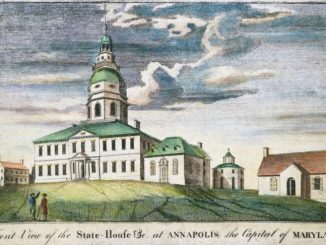


Leave a Reply